This Is Why Pluto Is Not a Planet

As Joni Mitchell pointed out, “You don’t know what you got ’til it’s gone.” Nowhere is this more apparent than in the Solar System.
Sure, day to day, most of us probably don’t think much about the massive celestial bodies that share this corner of the universe with us. I’d imagine most of us took for granted that there were nine planets—a fact, once upon a time, as unimpeachable as “the sun rises in the east” and “nothing can be said to be certain, except death and taxes.” But that all changed in 2006, when scientists decided to strip Pluto of its planet status practically overnight, rendering it simply a “dwarf planet.”
Pluto, once the smallest of the nine planets in the Solar System, was also the most recently discovered, spotted by 23-year-old astronomer Clyde Tombaugh in 1930. He had arrived at the Lowell Observatory in Flagstaff, Arizona, with the specific assignment of finding the elusive ninth “Planet X,” and after a year of photographing the night sky, spotted the moving object that would become known as Pluto (a name that 11-year-old British schoolgirl Venetia Burney had proposed).
The discovery was celebrated and hailed by the public and at the time it was estimated to be about the size of Earth. But doubts were soon cast first on the size of this icy new planet (in 1948, it was estimated to be just a tenth the size of earth, then a hundredth the size by 1976, and a 650th just two years later) and its classification.
According to the International Astronomical Union (IAU), which has overseen the naming and definitions of planetary bodies and their satellites since the early 1900s, a planet must (1) orbit the Sun and no other object, (2) have sufficient mass to be nearly round, and (3) has removed debris and small objects from the area around its orbit. It’s that last rule that created problems for Pluto.
Beginning in 1992, a number of other objects began to be spotted orbiting in the same part of the solar system as Pluto, and it was determined to be part of a donut-shaped group of objects which would be called the Kuiper belt. What was worse: many of these objects were almost as large as Pluto. What ultimately led to Pluto losing its classification as a planet was the discovery—on July 29, 2005, by CalTech astronomer Mike Brown—of Eris, an object larger than Pluto itself. The following year, the IAU determined that Pluto failed to meet the third criteria and should be reclassified, along with Eris, its moon Dysnomia and many other large but not that large planetary bodies as a “dwarf planet.” It was removed from planetary models at schools, museums and more.
The decision wasn’t without its own controversy. A number of scientists protested the IAU decision. The house of representatives in New Mexico (where Pluto discoverer Tombaugh was a longtime resident) passed a resolution that declared Pluto would be considered a planet within the state. Most recently, astronauts aboard the New Horizons mission to Pluto captured pictures of its rich surface and proposed in their subsequent book that the celestial body should be reinstated as a planet.
But, for now at least, the IAU remains unconvinced. From the organization’s official blog: “These results raise fundamental questions about how a small, cold planet can remain active over the age of the Solar System. They demonstrate that dwarf planets can be every bit as scientifically interesting as planets. Equally important is that all three major Kuiper belt bodies visited by spacecraft so far—Pluto, Charon, and Triton—are more different than similar, bearing witness to the potential diversity awaiting the exploration of their realm.” And if you want to know more about space, here are 30 Reasons Why the Ocean Is Scarier Than Space.
To discover more amazing secrets about living your best life, click here to follow us on Instagram!